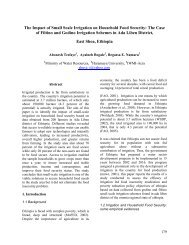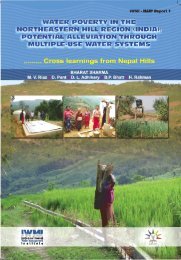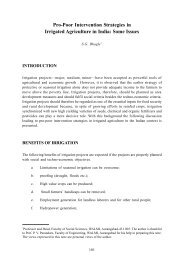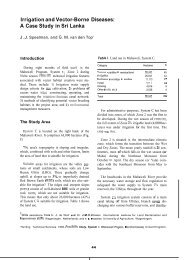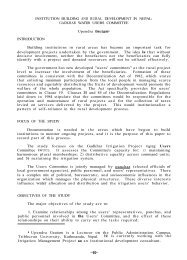A Case Study from System H, Sri Lanka
A Case Study from System H, Sri Lanka
A Case Study from System H, Sri Lanka
- No tags were found...
You also want an ePaper? Increase the reach of your titles
YUMPU automatically turns print PDFs into web optimized ePapers that Google loves.
Farmer-Oficer Coordination To Achieve Flexible Irrigation Scheduling31PLANNING FOR DELIVERY OPERATION AT DISTRIBUTARY CHANNEL LEVELThehoject Irrigation Engineer felt that the methods adopted in scheduling the existing system of water distribution couldbe re-organized and implemented in a more realistic and flexible manner with the help of the distributary channelorganization through dialoguebetween theofficers and farmerrepresentatives <strong>from</strong> thevery beginning to thecompletionof the season. Water requirements for land preparation, for example, vary within field channel areas, and even withindistributary channel areas. and it would be difficult for the engineering assistant and the unit manager in charge of waterdistribution to make any decisions unless they know the characteristics of the land, and also the problems that farmersface. It was considered that the distributary channel organization could meet the actual demands of the field and providethe feedback necessary to prepare a realistic water distribution schedule. In this setup the field channel area is clearlyidentified as a rotational unit and the distributary channel area as a rotational areaThe water management officers meet the distributary channel organization at every important stage of the cultivationseason and discuss the current situation in the cultivation operation in respect of the individual field channel.Distributary Channel Organization Meeting No. 1P1&n'eipation: Project Irrigation Engineer or representative. engineering assistant, agricultural officer, unitmaoagers, field assistants and all members of the distributary channel organization.Purpose: The overall decisions taken at the irrigation block cultivation meeting were rediscussed in detail. Thisdiscussion enabled the officers to convey more details that were important to organize the cultivation process.Depending on the total extent of cultivation and the percentage of different crops recommended by the SeasonalOperating Plan, the extent of each crop that could be recommended for the distributary channel and field channelareas were clearly identified. For more accuracy, a soil map prepared by the engineering assistants with theconcurrenceof the unit managers and farmers for the distributary channel areagiving the threemajor classes of soiltypes identified for individual irrigable allotments was tabled at this meeting (Figure 10). The extent of crops thatcould be cultivated in each field channel area and finally up to the distributary channel area were explained to thedistributary channel organization. The equity in water distribution among allotments was discussed in detail at thismeeting. The possibility of staggered land preparation within field channel and distributary channel areas withinthe overall land preparation period decided at the cultivation meeting was also discussed. The farmer leaders werefree to express their views about the period required to complete the land preparation operation. Consideration ofvarious factors such as labor, farm power and fmcial capabilities governing the duration of land preparation wasvery important at this stage. The 15-day period allocated for land preparation was generally accepted by thefanners. Accordingly, the field channel leaders in the distributary channel organization were thoroughly familiarwith the specifications regarding crop extent, and possible flexibility available for an intermittent land preparationoperation within their field channels.The progress of irrigation and drainage channel maintenance, and canal and structure repairs that were decidedon at the previous distributary channel organization meeting was also reviewed, and suitable dates for completionof such work were determined. Water allocations that could be made for land preparation and crop growth and thedifferent application methods were also explained to the farmer leaders.The farmer leaders of the distributary channel organization were then asked to inform all the other farmers in theirturnout of the matters discussed and the decisions laken, and discuss with them the cultivation plan.Distributary Channel Organization Meeting No. 2Participation: engineering assistant, unit managers, field assistants, and all members of the distributary channelorganization.hupose: One or two weeks before the fmt water issue the distributary channel organization met again with the



